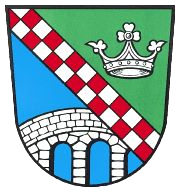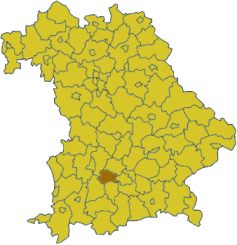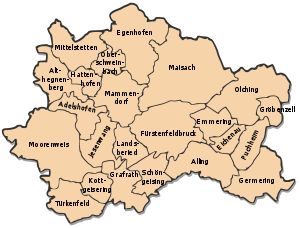Fürstenfeldbruck (district)
Fürstenfeldbruck is a district in Bavaria, Germany. It is bounded by (from the east and clockwise) the city of Munich and the districts of Munich, Starnberg, Landsberg, Aichach-Friedberg and Dachau.
History
In medieval times the region was a clerical state ruled by the abbey of Fürstenfeld. When the clerical states of Holy Empire were dissolved in 1803, the territory was annexed by Bavaria. The district of Fürstenfeldbruck was established in 1938.
Geography
The district is occupied by the western Munich metropolitan area. It has the highest population density of all Bavarian districts. More than 90 % of the population live in the eastern half of the district, which includes the suburbs of Munich.
Coat of arms
 |
- The red and white bar is from the family arms of Saint Bernard, who had been the founder of the Cistercian order (Fürstenfeld was a Cistercian monastery)
- The crown is from the arms of the abbot Alexander Pellhammer
- The bridge represents the city of Bruck (which was later merged with Fürstenfeld to form the city of Fürstenfeldbruck)
|
Towns and municipalities
| Towns |
Municipalities |
|
- Fürstenfeldbruck
- Germering
|
- Adelshofen
- Alling
- Althegnenberg
- Egenhofen
- Eichenau
- Emmering
- Grafrath
- Gröbenzell
- Hattenhofen
- Jesenwang
|
- Kottgeisering
- Landsberied
- Maisach
- Mammendorf
- Mittelstetten
- Moorenweis
- Oberschweinbach
- Olching
- Puchheim
- Schöngeising
- Türkenfeld
|
External links
 Urban and rural districts in the Free State of Bavaria in Germany Urban and rural districts in the Free State of Bavaria in Germany  |
|
Urban
districts |
|
|
Rural
districts |
Aichach-Friedberg · Altötting · Amberg-Sulzbach · Ansbach · Aschaffenburg · Augsburg · Bad Kissingen · Bad Tölz-Wolfratshausen · Bamberg · Bayreuth · Berchtesgadener Land · Cham · Coburg · Dachau · Deggendorf · Dillingen · Dingolfing-Landau · Donau-Ries · Ebersberg · Eichstätt · Erding · Erlangen-Höchstadt · Forchheim · Freising · Freyung-Grafenau · Fürstenfeldbruck · Fürth · Garmisch-Partenkirchen · Günzburg · Haßberge · Hof · Kelheim · Kitzingen · Kronach · Kulmbach · Landsberg · Landshut · Lichtenfels · Lindau · Main-Spessart · Miesbach · Miltenberg · Mühldorf · München (Munich) · Neuburg-Schrobenhausen · Neumarkt · Neustadt (Aisch)-Bad Windsheim · Neustadt (Waldnaab) · Neu-Ulm · Nürnberger Land · Oberallgäu · Ostallgäu · Passau · Pfaffenhofen · Regen · Regensburg · Rhön-Grabfeld · Rosenheim · Roth · Rottal-Inn · Schwandorf · Schweinfurt · Starnberg · Straubing-Bogen · Tirschenreuth · Traunstein · Unterallgäu · Weilheim-Schongau · Weißenburg-Gunzenhausen · Wunsiedel · Würzburg |
|


